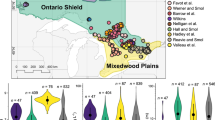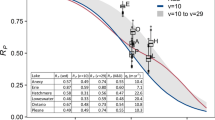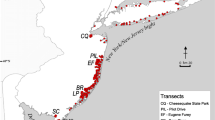Abstract
Diatoms respond rapidly to eutrophication and diatom-based models for inferring total phosphorus (TP) have found wide application in palaeolimnology, especially in tracking trajectories of past and recent nutrient enrichment and in establishing pre-disturbance targets for restoration. Using new analysis of existing training sets and sediment-cores we examine the statistical and ecological constraints of diatom-inferred TP (DI-TP) models. Although the models show an apparently strong relationship between measured and inferred TP in the training sets, even under cross-validation, the models display three fundamental weaknesses, namely (1) the relationship between TP and diatom relative abundance is heavily confounded with secondary variables such as alkalinity and lake depth, (2) the models contain many taxa that are not significantly related to TP, and (3) comparison between different models shows poor or no spatial replicability. At some sites the sediment-core diatom assemblage change tracks the TP gradient in the training sets and DI-TP reconstructions are consistent with monitored TP data and known catchment histories for the recent past. At others diatom species turnover is apparently related to variables other than TP, and DI-TP fails to even reproduce plausible trends. Pre-disturbance DI-TP values are also questionable at most sites. We argue that these problems pervade many DI-TP models, particularly those where violations of the basic assumptions of the transfer function approach are ignored.





Similar content being viewed by others
References
Adler S, Hubener T (2007) Spatial variability of diatom assemblages in surface lake sediments and its implications for transfer functions. J Paleolimnol 37:573–590
Anderson NJ (1989) A whole-basin diatom accumulation rate for a small eutrophic lake in Northern Ireland and its paleoecological implications. J Ecol 77:926–946
Anderson NJ (1995) Using the past to predict the future: lake sediments and the modelling of limnological disturbance. Ecol Model 78:149–172
Anderson NJ (1998) Variability of diatom-inferred phosphorus profiles in a small lake basin and its implications for histories of lake eutrophication. J Paleolimnol 20:47–55
Anderson NJ (2000) Diatoms, temperature and climate change. Eur J Phycol 35:307–314
Anderson NJ, Odgaard BV (1994) Recent palaeolimnology of three shallow Danish lakes. Hydrobiologia 275:411–422
Anderson NJ, Rippey B (1994) Monitoring lake recovery from point-source eutrophication—the use of diatom-inferred epilimnetic total phosphorus and sediment chemistry. Freshw Biol 32:625–639
Anderson NJ, Foy RH, Engstrom DR, Rippey B, Almgir F (2012) Climate forcing of diatom productivity in a lowland, eutrophic lake: White Lough revisited. Freshw Biol 57:2030–2043
Appleby PG (2001) Chronostratigraphic techniques in recent sediments. In: Last WM, Smol JP (eds) Tracking environmental change using lake sediments: basin analysis, coring, and chronological techniques. Springer, Dordrecht, pp 171–203
Battarbee RW, Bennion H (2012) Using palaeolimnological and limnological data to reconstruct the recent history of European lake ecosystems: introduction. Freshw Biol 57:1979–1985
Battarbee RW, Anderson NJ, Bennion H, Simpson GL (2012) Combining limnological and palaeolimnological data to disentangle the effects of nutrient pollution and climate change on lake ecosystems: problems and potential. Freshw Biol 57:2091–2106
Bennion H (1995) Surface-sediment diatom assemblages in shallow, artificial, enriched ponds, and implications for reconstructing trophic status. Diatom Res 10:1–19
Bennion H, Battarbee RW (2007) The European Union Water Framework Directive: opportunities for palaeolimnology. J Paleolimnol 38:285–295
Bennion H, Wunsam S, Schmidt R (1995) The validation of diatom-phosphorus transfer-functions—an example from Mondsee, Austria. Freshw Biol 34:271–283
Bennion H, Juggins S, Anderson NJ (1996) Predicting epilimnetic phosphorus concentrations using an improved diatom-based transfer function and its application to lake eutrophication management. Environ Sci Technol 30:2004–2007
Bennion H, Appleby PG, Phillips GL (2001) Reconstructing nutrient histories in the Norfolk Broads, UK: implications for the role of diatom-total phosphorus transfer functions in shallow lake management. J Paleolimnol 26:181–204
Bennion H, Sayer C, Tibby T, Carrick H (2010) Diatoms as indicators of environmental change in shallow lakes. In: Smol JP, Stoermer EF (eds) The diatoms: applications for the environmental and earth sciences. Cambridge University Press, Cambridge, pp 152–173
Oksanen J, Blanchet, FG, Kindt, R, Legendre P, Minchin PR, O’Hara RB, Simpson GL, Solymos P, Stevens MHM, Wagner H (2012) Vegan: community ecology package. R package version 2.0-4. http://CRAN.R-project.org/package=vegan
Bradbury JP (1975) Diatom stratigraphy and human settlement in Minnesota. The Geological Society of America, Boulder
Bradshaw EG, Anderson NJ (2001) Validation of a diatom-phosphorus calibration set for Sweden. Freshw Biol 46:1035–1048
Bradshaw EG, Anderson NJ (2003) Environmental factors that control the abundance of Cyclostephanos dubius (Bacillariophyceae) in Danish lakes, from seasonal to century scale. Eur J Phycol 38:265–276
Bradshaw EG, Anderson NJ, Jensen JP, Jeppesen E (2002) Phosphorus dynamics in Danish lakes and the implications for diatom ecology and palaeoecology. Freshw Biol 47:1963–1975
Bradshaw EG, Rasmussen P, Nielsen H, Anderson NJ (2005) Mid- to late-Holocene land-use change and lake development at Dallund So, Denmark: trends in lake primary production as reflected by algal and macrophyte remains. Holocene 15:1130–1142
Carpenter SR, Caraco NF, Correll DL, Howarth RW, Sharpley AN, Smith VH (1998) Nonpoint pollution of surface waters with phosphorus and nitrogen. Ecol Appl 8:559–568
Chapra SC (1977) Total phosphorus model for the Great Lakes. J Environ Eng Div Am Soc Civ Eng 103:147–161
Dodds WK, Bouska WW, Eitzmann JL, Pilger TJ, Pitts KL, Riley AJ, Schloesser JT, Thornbrugh DJ (2009) Eutrophication of US freshwaters: analysis of potential economic damages. Environ Sci Technol 43:12–19
Dong XH, Bennion H, Battarbee RW, Yang XD, Yang HD, Liu EF (2008) Tracking eutrophication in Taihu Lake using the diatom record: potential and problems. J Paleolimnol 40:413–429
Edlund MB (2005) Using diatom-based analysis of sediment records from Central Minnesota lakes for TMDL and nutrient criteria development. Final report to the Minnesota Pollution Control Agency, 25 pp
Edlund MB, Kingston J (2004) Expanding sediment diatom reconstruction model to eutrophic Southern Minnesota lakes. Final report submitted to the Minnesota Pollution Control Agency, 33 pp
Edlund MB, Ramstack JM (2009) Historical water quality and biological change in Northcentral Minnesota lakes. Final report submitted to the Minnesota Pollution Control Agency from the St. Croix Watershed Research Station, Marine on St. Croix, MN, 84 pp
Enache M, Prairie YT (2002) WA-PLS diatom-based pH, TP and DOC inference models from 42 lakes in the Abitibi clay belt area (Quebec, Canada). J Paleolimnol 27:151–171
Foy RH, Lennox SD, Gibson CE (2003) Changing perspectives on the importance of urban phosphorus inputs as the cause of nutrient enrichment in Lough Neagh. Sci Total Environ 310:87–99
Fritz SC, Kingston JC, Engstrom DR (1993) Quantitative trophic reconstruction from sedimentary diatom assemblages: a cautionary tale. Freshw Biol 30:1–23
Gibson CE, Anderson NJ, Haworth EY (2003) Aulacoseira subarctica: taxonomy, physiology, ecology and palaeoecology. Eur J Phycol 38:83–101
Gregory-Eaves I, Smol JP, Finney BP, Edwards ME (1999) Diatom-based transfer functions for inferring past climatic and environmental changes in Alaska, USA. Arct Antarct Alp Res 31:353–365
Hall RI, Smol JP (1992) A weighted-averaging regression and calibration model for inferring total phosphorus concentration from diatoms in British Columbia (Canada) lakes. Freshw Biol 27:417–434
Hall RI, Smol JP (2010) Diatoms as indicators of lake eutrophication. In: Smol JP, Stoermer EF (eds) The diatoms: applications for the environmental and earth sciences. Cambridge University Press, Cambridge, pp 122–151
Hobbie JE, Likens GE (1973) Output of phosphorus, dissolved organic carbon, and fine particulate carbon from Hubbard Brook watersheds. Limnol Oceanogr 18:734–742
Jeppesen E, Kristensen P, Jensen JP, Søndergaard M, Mortensen E, Lauridsen T (1991) Recovery resilience following a reduction in external phosphorus loading of shallow eutrophic Danish lakes: duration, regulating factors and methods for overcoming resilience. Mem Ist Ital Idrobiol 48:127–148
Jeppesen E, Sondergaard M, Kronvang B, Jensen JP, Svendsen LM, Lauridsen TL (1999) Lake and catchment management in Denmark. Hydrobiologia 395:419–432
Jeppesen E, Kronvang B, Meerhoff M, Sondergaard M, Hansen KM, Andersen HE, Lauridsen TL, Liboriussen L, Beklioglu M, Ozen A, Olesen JE (2009) Climate change effects on runoff, catchment phosphorus loading and lake ecological state, and potential adaptations. J Environ Qual 38:1930–1941
Juggins S (2012) Rioja: analysis of quaternary science data. R package version (0.8-2). (http://cran.r-project.org/package=rioja)
Juggins S (2013) Palaeolimnological transfer functions: new paradigm or sick science? J Quat Res. doi:10.1016/j.quascirev.2012.12.014
Juggins S, Birks HJB (2012) Quantitative environmental reconstructions from biological data. In: Birks HJB, Lotter AF, Juggins S, Smol JP (eds) Tracking environmental change using lake sediments: data handling and numerical techniques. Springer, Dordrecht, pp 431–494
Lauridsen TL, Jeppesen E, Andersen FO (1993) Colonization of submerged macrophytes in shallow fish manipulated Lake Vaeng—impact of sediment composition and waterfowl grazing. Aquat Bot 46:1–15
Lauridsen TL, Jeppesen E, Sondergaard M (1994) Colonization and succession of submerged macrophytes in shallow Lake Vaeng during the 1st 5 years following fish manipulation. Hydrobiologia 275:233–242
Leps J, Smilauer P (2003) Multivariate analysis of ecological data using CANOCO. Cambridge University Press, Cambridge
Lotter AF (1998) The recent eutrophication of Baldeggersee (Switzerland) as assessed by fossil diatom assemblages. Holocene 8:395–405
Lotter AF, Birks HJB, Hofmann W, Marchetto A (1998) Modern diatom, cladocera, chironomid, and chrysophyte cyst assemblages as quantitative indicators for the reconstruction of past environmental conditions in the Alps. II. Nutrients. J Paleolimnol 19:443–463
May L, Defew LH, Bennion H, Kirika A (2012) Historical changes (1905–2005) in external phosphorus loads to Loch Leven, Scotland, UK. Hydrobiologia 681:11–21
Mohler CL (1983) Effect of sampling pattern on estimation of species distributions along gradients. Vegetatio 54:97–102
MPCA (Minnesota Pollution Control Agency) (2012) http://www.pca.state.mn.us/water/clmp/lkwqReadFull.cfm?lakeid=21-0081. Accessed May 2012
Newman EI (1995) Phosphorus inputs to terrestrial ecosystems. J Ecol 83:713–726
Omernik JM (1987) Ecoregions of the conterminous United States (map supplement). Ann Assoc Am Geogr 77:118–125
Philibert A, Prairie YT (2002) Is the introduction of benthic species necessary for open-water chemical reconstruction in diatom-based transfer functions? Can J Fish Aquat Sci 59:938–951
Ramstack JM, Edlund MB (2008) Paleolimnological analysis of Horse Lake and Lotus Lake, Polk County, Wisconsin. Final report to the Polk County, WI Land and Water Resources Department, 30 pp
Ramstack JM, Fritz SC, Engstrom DR, Heiskary SA (2003) The application of a diatom-based transfer function to evaluate regional water-quality trends in Minnesota since 1970. J Paleolimnol 29:79–94
Reavie E, Smol JP (2001) Diatom-environmental relationships in 64 alkaline southeastern Ontario (Canada) lakes: a diatom-based model for water quality reconstructions. J Paleolimnol 25:25–42
Reavie E, Kingston J, Peterson M, Edlund MB (2005) Sediment diatom reconstruction model for Minnesota lakes. Final report to the Itasca Soil and Water Conservation District, 36 pp
Reynolds CS (1984) The ecology of freshwater phytoplankton. Cambridge University Press, Cambridge
Reynolds CS, Davies PS (2001) Sources and bioavailability of phosphorus fractions in freshwaters: a British perspective. Biol Rev 76:27–64
Rippey B, Anderson NJ (1996) Reconstruction of lake phosphorus loading and dynamics using the sedimentary record. Environ Sci Technol 30:1786–1788
Rippey B, Anderson NJ, Foy RH (1997) Accuracy of diatom-inferred total phosphorus concentrations and the accelerated eutrophication of a lake due to reduced flushing and increased internal loading. Can J Fish Aquat Sci 54:2637–2646
Sayer CD (2001) Problems with the application of diatom-total phosphorus transfer functions: examples from a shallow English lake. Freshw Biol 46:743–757
Schindler DW (1977) Evolution of phosphorus limitation in lakes: natural mechanisms compensate for deficiencies of nitrogen and carbon in eutrophied lakes. Science 195:260–262
Sharpley AN, Chapra SC, Wedepohl R, Sims JT, Daniel TC, Reddy KR (1994) Managing agricultural phosphorus for protection of surface waters: issues and options. J Environ Protect 23:437–451
Shinneman ALC, Bennett DM, Fritz SC, Schmieder J, Engstrom DR, Efting A, Holz J (2010) Inferring lake depth using diatom assemblages in the shallow, seasonally variable lakes of the Nebraska Sand Hills (USA): calibration, validation, and application of a 69-lake training set. J Paleolimnol 44:443–464
Siver PA (1999) Development of paleolimnological inference models for pH, total nitrogen and specific conductivity based on planktonic diatoms. J Paleolimnol 21:45–59
Smil V (2000) Phosphorus in the environment: natural flows and human interferences. Annu Rev Energy Environ 25:53–88
Smith VH, Tilman GD, Nekola JC (1999) Eutrophication: impacts of excess nutrient inputs on freshwater, marine, and terrestrial ecosystems. Environ Pollut 100:179–196
Smith VH, Joye SB, Howarth RW (2006) Eutrophication of freshwater and marine ecosystems. Limnol Oceanogr 51:351–355
Stauffer RE (1988) Sampling strategies and associated errors in estimating epilimnetic chlorophyll in eutrophic lakes. Water Resour Res 24:1459–1469
Stevenson R, Bothwell ML, Lowe RL (1996) Algal ecology: freshwater benthic ecosystems. Academic Press, San Diego
R Core Team (2012) R: a language and environment for statistical computing. R Foundation for Statistical Computing, Vienna, Austria. ISBN: 3-900051-07-0, http://www.R-project.org/
Telford RJ, Birks HJB (2011) Effect of uneven sampling along an environmental gradient on transfer-function performance. J Paleolimnol 46:99–106
van der Voet H (1994) Comparing the predictive accuracy of models using a simple randomization test. Chemom Intell Lab 25:313–323
Velle G, Brodersen KP, Birks HJB, Willassen E (2010) Midges as quantitative temperature indicator species: lessons for palaeoecology. Holocene 20:989–1002
Vighi M, Chiaudani G (1985) A simple method to estimate lake phosphorus concentrations resulting from natural, background, loadings. Water Res 19:987–991
Willén E (1991) Planktonic diatoms—an ecological review. Algol Stud 62:69–106
Wood SN (2006) Generalized additive models: an introduction with R. Chapman Hall/CRC, Boca Raton
Wunsam S, Schmidt R (1995) A diatom-phosphorus transfer function for Alpine and pre-Alpine lakes. Mem Ist Ital Idrobiol 53:85–99
Yee TW, Mitchell ND (1991) Generalized additive models in plant ecology. J Veg Sci 2:587–602
Acknowledgments
As former PhD. students, it is a pleasure for SJ and NJA to acknowledge the guidance offered by Rick Battarbee as well as the many hours discussing the pitfalls and possibilities of quantifying diatom ecological distributions and change in lake sediment records. The MN training set was assembled by numerous investigators, including Mark Edlund, Euan Reavie, John Kingston, Sherilyn Fritz, Daniel Engstrom and Steven Heiskary. JMRH and this work were supported in part by National Science Foundation grant DEB-0919095. We would also like to thank the St. Croix Watershed Research Station for providing housing and workspace for the authors that was critical to the completion of this paper. We are grateful to Helen Bennion and an anonymous reviewer for valuable comments on an earlier version of the manuscript.
Author information
Authors and Affiliations
Corresponding author
Additional information
A celebration of Prof Rick Battarbee's contributions to palaeolimnology, edited by Holmes et al.
Rights and permissions
About this article
Cite this article
Juggins, S., Anderson, N.J., Hobbs, J.M.R. et al. Reconstructing epilimnetic total phosphorus using diatoms: statistical and ecological constraints. J Paleolimnol 49, 373–390 (2013). https://doi.org/10.1007/s10933-013-9678-x
Received:
Accepted:
Published:
Issue Date:
DOI: https://doi.org/10.1007/s10933-013-9678-x




